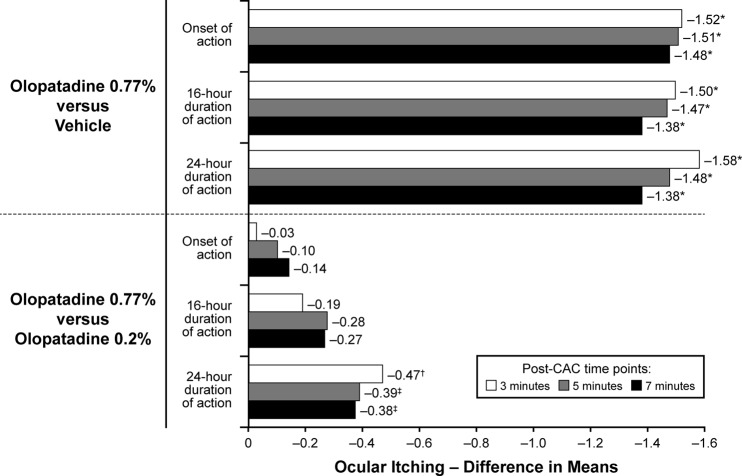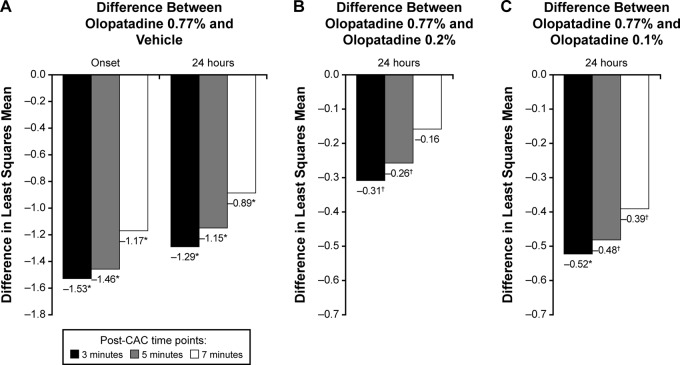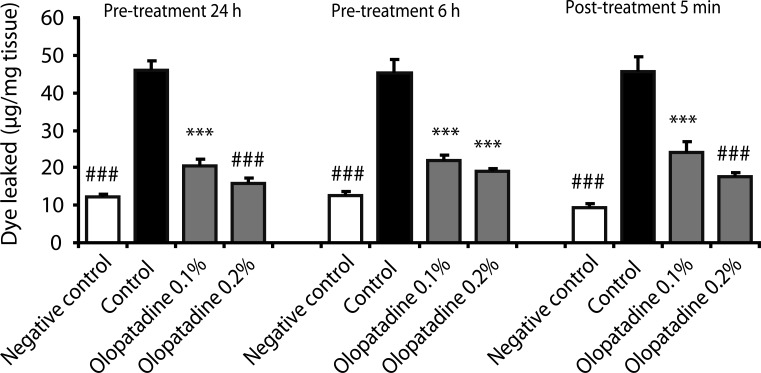
| Size | Price | Stock | Qty |
|---|---|---|---|
| 25mg |
|
||
| 50mg |
|
||
| 100mg |
|
||
| 250mg |
|
||
| 500mg |
|
||
| 1g |
|
||
| Other Sizes |
|
Purity: ≥98%
Olopatadine HCl (Pataday; Patanase; KW-4679; ALO-4943A; ALO4943A; KW4679), the hydrochloride salt of olopatadine, is a 2nd-generation, selective histamine H1 receptor (IC50 of 559 μM for the release of histamine) antagonist and also a mast cell stabilizer used to treat itching associated with allergic conjunctivitis (eye allergies), it may also be used for the treatment of steroid rebound (red skin syndrome).
| Targets |
Histamine receptor
|
||
|---|---|---|---|
| ln Vitro |
|
||
| ln Vivo |
|
||
| Animal Protocol |
|
||
| References |
|
||
| Additional Infomation |
Olopatadine hydrochloride is a dibenzooxazepine.
Olopatadine Hydrochloride is the hydrochloride salt form of olopatadine, a dual action selective histamine H1 receptor antagonist and mast cell stabilizer with anti-allergic activity. Olopatadine stabilizes mast cells and prevents histamine release from mast cells. In addition, this agent also blocks histamine H1 receptors, thereby preventing histamine from binding to these receptors. Both actions prevent the effects of histamine on capillaries, bronchial smooth muscle, and gastrointestinal (GI) smooth muscle, including histamine-induced vasodilation, increased capillary permeability, bronchoconstriction, and spasmodic contraction of GI smooth muscle. This drug also prevents histamine-induced pain and itching of mucous membranes. An antihistamine with mast-cell stabilizing properties used as eye drops in the treatment of ALLERGIC CONJUNCTIVITIS. See also: Olopatadine (has active moiety); Mometasone furoate; olopatadine hydrochloride (component of) ... View More ... Drug Indication Treatment of ocular signs and symptoms of seasonal allergic conjunctivitis. , |
| Molecular Formula |
C21H24CLNO3
|
|
|---|---|---|
| Molecular Weight |
373.87
|
|
| Exact Mass |
373.144
|
|
| Elemental Analysis |
C, 67.46; H, 6.47; Cl, 9.48; N, 3.75; O, 12.84
|
|
| CAS # |
140462-76-6
|
|
| Related CAS # |
Olopatadine-d3 hydrochloride; 1331635-21-2; (Z)-Olopatadine-d3 hydrochloride; Olopatadine; 113806-05-6
|
|
| PubChem CID |
5282402
|
|
| Appearance |
White to off-white solid powder
|
|
| Density |
1.221 g/cm3
|
|
| Boiling Point |
523ºC at 760mmHg
|
|
| Melting Point |
242-245ºC
|
|
| Flash Point |
270.1ºC
|
|
| Vapour Pressure |
9.65E-13mmHg at 25°C
|
|
| LogP |
4.391
|
|
| Hydrogen Bond Donor Count |
2
|
|
| Hydrogen Bond Acceptor Count |
4
|
|
| Rotatable Bond Count |
5
|
|
| Heavy Atom Count |
26
|
|
| Complexity |
488
|
|
| Defined Atom Stereocenter Count |
0
|
|
| SMILES |
Cl[H].O1C([H])([H])C2=C([H])C([H])=C([H])C([H])=C2/C(=C(\[H])/C([H])([H])C([H])([H])N(C([H])([H])[H])C([H])([H])[H])/C2C([H])=C(C([H])([H])C(=O)O[H])C([H])=C([H])C1=2
|
|
| InChi Key |
HVRLZEKDTUEKQH-NOILCQHBSA-N
|
|
| InChi Code |
InChI=1S/C21H23NO3.ClH/c1-22(2)11-5-8-18-17-7-4-3-6-16(17)14-25-20-10-9-15(12-19(18)20)13-21(23)24;/h3-4,6-10,12H,5,11,13-14H2,1-2H3,(H,23,24);1H/b18-8-;
|
|
| Chemical Name |
2-[(11Z)-11-[3-(dimethylamino)propylidene]-6H-benzo[c][1]benzoxepin-2-yl]acetic acid;hydrochloride
|
|
| Synonyms |
|
|
| HS Tariff Code |
2934.99.9001
|
|
| Storage |
Powder -20°C 3 years 4°C 2 years In solvent -80°C 6 months -20°C 1 month Note: Please store this product in a sealed and protected environment, avoid exposure to moisture. |
|
| Shipping Condition |
Room temperature (This product is stable at ambient temperature for a few days during ordinary shipping and time spent in Customs)
|
| Solubility (In Vitro) |
|
|||
|---|---|---|---|---|
| Solubility (In Vivo) |
Solubility in Formulation 1: ≥ 2.5 mg/mL (6.69 mM) (saturation unknown) in 10% DMSO + 40% PEG300 + 5% Tween80 + 45% Saline (add these co-solvents sequentially from left to right, and one by one), clear solution.
For example, if 1 mL of working solution is to be prepared, you can add 100 μL of 25.0 mg/mL clear DMSO stock solution to 400 μL PEG300 and mix evenly; then add 50 μL Tween-80 to the above solution and mix evenly; then add 450 μL normal saline to adjust the volume to 1 mL. Preparation of saline: Dissolve 0.9 g of sodium chloride in 100 mL ddH₂ O to obtain a clear solution. Solubility in Formulation 2: ≥ 2.5 mg/mL (6.69 mM) (saturation unknown) in 10% DMSO + 90% (20% SBE-β-CD in Saline) (add these co-solvents sequentially from left to right, and one by one), clear solution. For example, if 1 mL of working solution is to be prepared, you can add 100 μL of 25.0 mg/mL clear DMSO stock solution to 900 μL of 20% SBE-β-CD physiological saline solution and mix evenly. Preparation of 20% SBE-β-CD in Saline (4°C,1 week): Dissolve 2 g SBE-β-CD in 10 mL saline to obtain a clear solution. View More
Solubility in Formulation 3: ≥ 2.5 mg/mL (6.69 mM) (saturation unknown) in 10% DMSO + 90% Corn Oil (add these co-solvents sequentially from left to right, and one by one), clear solution. Solubility in Formulation 4: 17.14 mg/mL (45.84 mM) in PBS (add these co-solvents sequentially from left to right, and one by one), clear solution; with ultrasonication. |
| Preparing Stock Solutions | 1 mg | 5 mg | 10 mg | |
| 1 mM | 2.6747 mL | 13.3736 mL | 26.7473 mL | |
| 5 mM | 0.5349 mL | 2.6747 mL | 5.3495 mL | |
| 10 mM | 0.2675 mL | 1.3374 mL | 2.6747 mL |
*Note: Please select an appropriate solvent for the preparation of stock solution based on your experiment needs. For most products, DMSO can be used for preparing stock solutions (e.g. 5 mM, 10 mM, or 20 mM concentration); some products with high aqueous solubility may be dissolved in water directly. Solubility information is available at the above Solubility Data section. Once the stock solution is prepared, aliquot it to routine usage volumes and store at -20°C or -80°C. Avoid repeated freeze and thaw cycles.
Calculation results
Working concentration: mg/mL;
Method for preparing DMSO stock solution: mg drug pre-dissolved in μL DMSO (stock solution concentration mg/mL). Please contact us first if the concentration exceeds the DMSO solubility of the batch of drug.
Method for preparing in vivo formulation::Take μL DMSO stock solution, next add μL PEG300, mix and clarify, next addμL Tween 80, mix and clarify, next add μL ddH2O,mix and clarify.
(1) Please be sure that the solution is clear before the addition of next solvent. Dissolution methods like vortex, ultrasound or warming and heat may be used to aid dissolving.
(2) Be sure to add the solvent(s) in order.
| NCT Number | Recruitment | interventions | Conditions | Sponsor/Collaborators | Start Date | Phases |
| NCT03186755 | Recruiting | Drug: Hyaluronic acid 0.05% & Ectoine 2.0% Drug: Olopatadine hydrochloride ophthalmic solution 0.1% |
Conjunctivitis, Allergic Conjunctivitis, Vernal |
Michael Marchand, MD | June 11, 2017 | Phase 4 |
| NCT06126952 | Recruiting | Drug: Treatment A: Azelastine hydrochloride 0.15% nasal spray (Azelair) Drug: Treatment B: Placebo (Azelastine 0.15% vehicle) nasal spray |
Seasonal Allergic Rhinitis | MEDA Pharma GmbH & Co. KG | October 30, 2023 | Phase 2 |
| NCT00775658 | Completed | Drug: olopatadine Drug: placebo |
Allergic Rhinitis Allergic Conjunctivitis |
Vanderbilt University Medical Center |
January 2008 | Not Applicable |
| NCT01697969 | Completed | Drug: Olopatadine hydrochloride ophthalmic solution, 0.2% |
Allergic Conjunctivitis | Alcon Research | September 2012 | Phase 4 |
| NCT00609128 | Completed | Drug: olopatadine | Allergic Conjunctivitis | University of Wisconsin, Madison |
September 2000 | Not Applicable |
 |
|---|
 |
 |